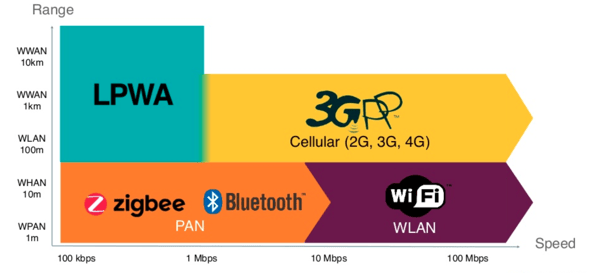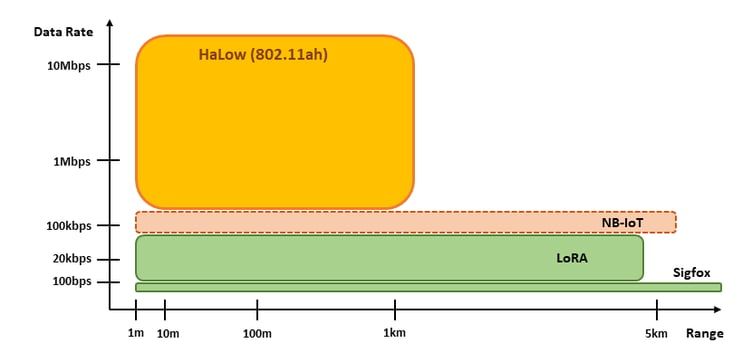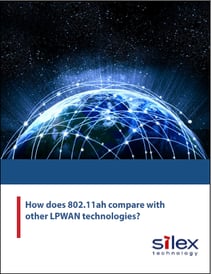Posted by Rachael Plotkin, April 10, 2020
How Does 802.11ah Compare with Other LPWAN Technologies?
The Internet of Things (IoT) consists of millions of constrained devices communicating over the Internet or the network. Existing low power wireless network technologies for connecting IoT devices fall into three groups:
- Wireless Personal Area Networking (WPAN) technologies that provide connectivity up to tens of meters (e.g., ZigBee, Bluetooth Low Energy).
- Wireless Local Area Networking (WLAN) technologies that offer greater reach than WPAN and shorter than LPWAN (Standard Wi-Fi 802.11 a/b/g/n/ac, Mesh, etc.).
- Low-Power Wide-Area Networking (LPWAN) technologies that offer an extended range up to several kilometers but sacrifice in terms of throughput (e.g., LoRaWAN, Sigfox, NB-IoT, Wi-Fi HaLowTM).

While WPAN technologies can maintain a lower power than WLAN technologies, WLAN technologies offer greater reach than WPAN technologies, but shorter reach in comparison to LPWAN technologies. As a result, LPWAN technologies provide the best option for meeting the needs of high coverage, low-power IoT device connectivity, and are set to experience massive growth within the coming years.
However, for IoT device manufacturers and solution developers, choosing the wrong LPWAN technology can result in a costly mistake, as these technologies are often complicated to understand, and provide competing claims on their ability to meet the needs of IoT applications.
To help uncover the LPWAN that is the best fit for your IoT application, Silex's has created a white paper, How Does 802.11ah Compare with Other LPWAN Technologies?
In addition to 802.11ah Wi-Fi HaLow technology, this white paper explores the technical differences and similarities and pros and cons of each of the below LPWAN technologies, which are:
- Wi-Fi HaLow TM (802.11ah)
- LoRaWan
- SigFox
- NB-IoT
 Not only does this white paper resource look at each LPWAN technology from a technical perspective, it also looks at these technologies from a business model perspective by highlighting specific factors that are fundamental to consider before making a final technology selection, including:
Not only does this white paper resource look at each LPWAN technology from a technical perspective, it also looks at these technologies from a business model perspective by highlighting specific factors that are fundamental to consider before making a final technology selection, including:
- The use of licensed or unlicensed technology
- The Quality of Service requirements
- Battery Life
- Scalability
- Coverage and range
- Cost
Ultimately, Silex identified 802.11ah Wi-Fi HaLow as the best technology option for IoT device connectivity, as it promises a considerably extended range compared to WPAN technologies and maintains a higher bit-rate compared to other than LPWAN technologies. Do you agree with Silex's analysis? Let us know why or not you feel 802.11ah WiFi HaLow will emerge as the future of wireless connectivity in the IoT space.
For even more information on 802.11ah Wi-Halow, be sure to watch our on-demand webinar, How 802.11ah (Wi-Fi HaLow) Technology is Revolutionizing IoT Connectivity, which introduces Silex's SX-NEWAH, the market's first 802.11ah capable certified module.


